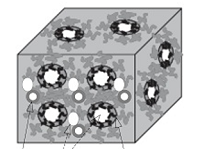Transparent Nanofoam Polymer

Technology Description:
Argonne National Laboratory (ANL) with its partners will develop a transparent nanofoam polymer that can be incorporated into a window film/coating for single-pane windows. The transparent polymer-nanoparticle composite will be applied to glass, and will improve the thermal insulation and the soundproofing of a window. Key to this technology is the generation of small and hollow nanometer-sized particles with thin shells. These will be embedded in a polymer with a carefully controlled structure and uniform dispersal of nanoshells in the polymer matrix. Competing approaches such as those used for silica aerogels have limited ability to fine tune the material's structure, resulting in materials with weaker mechanical strength, difficulties with transparency, and high processing costs. ANL will develop materials fabricated with self-assembly and a level of precision that allows careful prediction of how light and heat transmit through the material. The team also plans to introduce ultrasound-enhanced continuous processing techniques to manufacture the nanofoam at low cost and with high transparency without undesired haze and enhanced sound isolation capabilities. ANL predicts that the technology will enable an inexpensive window film that can be installed by the homeowner to upgrade a single-glazed window to double-glazed performance at about 25% of the cost.
Potential Impact:
If successful, ANL’s innovations will enable energy-efficient retrofits for the substantial remaining stock of single-pane windows in the United States. Retrofitting single-pane windows could produce significant economic and environmental benefits. These technologies could help reduce building energy consumption and save money for homeowners and businesses. Consumers adopting these retrofits could also benefit from improved window performance, including greater comfort and condensation resistance in cold weather and better soundproofing. Finally, by consuming less electricity, natural gas, and/or heating oil to warm a building, these technologies reduce the greenhouse gas emissions associated with using these energy sources.
Contact
ARPA-E Program Director:
Dr. Marina Sofos
Project Contact:
Dr. Jie Li
Press and General Inquiries Email:
ARPA-E-Comms@hq.doe.gov
Project Contact Email:
jieli@anl.gov
Partners
University of Chicago
Temple University
Lawrence Berkeley National Laboratory
Related Projects
Release Date:
10/07/2015
